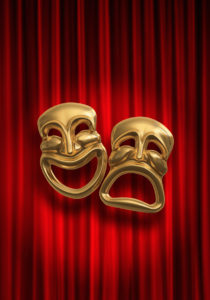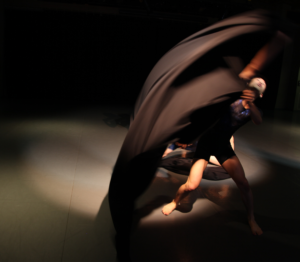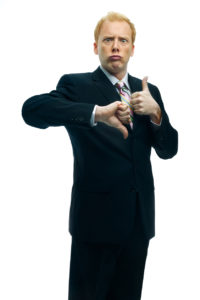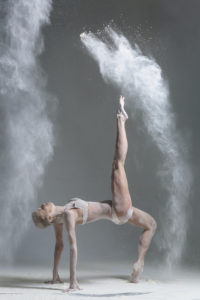By Alison Henderson, Registered Movement Pattern Analyst
 One problem for an actor is character similarity — does each character portrayed exhibit the actor’s habitual movements? Having a Movement Pattern Analysis profile gives the actor an understanding of his own thought process so he can see how it differs from his character’s process. Moreover, he can learn his personal movement characteristics/habits that arise from this thought process.
One problem for an actor is character similarity — does each character portrayed exhibit the actor’s habitual movements? Having a Movement Pattern Analysis profile gives the actor an understanding of his own thought process so he can see how it differs from his character’s process. Moreover, he can learn his personal movement characteristics/habits that arise from this thought process.
Until now, movement training has looked at body habits separate from the thought process, rather than connected. Actors are taught to go to a “neutral” place devoid of natural habits rather than understanding their organic movement in the deep way that comes from the MPA profile experience.
As an actor and director, I saw a direct relationship between MPA and character development early in my own MPA training. MPA bridges the psychological and physical. By analyzing a text for a character’s thought process (psychological motivation of the character), the type of movement shape and effort qualities from the MPA framework that will match the thought can be utilized by an actor for physical character transformation. With his MPA Profile, he will know which movements from his habits match the character and what he needs to change. As Laban stated, “It is of the greatest importance for the actor-dancer to recognize that such habitual inner attitudes (i.e. Decision-Making Preferences uncovered by MPA) are the basic indications of what we call character and temperament” (parenthetical phrase mine).
Finally, MPA can smooth the transition for actors between movement in the studio and movement on the stage. By changing the intensity of the effort and shape discovered through MPA-based text analysis, actors can be fully embodied on stage in every genre without the fears of movement appearing “put on” or work in the studio not transferring well to “realistic” acting. My own MPA Training for Actors called TYPE (Transform Your Predictable Expression) is still in development. However, I see a future where movement directors are part of every production because movement is crucial to creating the world of the play—moving all theater to include physicality rather than confining movement to the separate genre of “physical theater.”


 In the 1940s, Rudolf Laban took his dance theories into the world of work, addressing issues of efficiency, job satisfaction, and reduction of fatigue on the factory floor.
In the 1940s, Rudolf Laban took his dance theories into the world of work, addressing issues of efficiency, job satisfaction, and reduction of fatigue on the factory floor. As the benefits of physical motion are gaining recognition and undergoing further scrutiny, it is interesting to see how Laban characterized movement health. He wrote, “A healthy human being can have complete control of his kinesphere and dynamosphere…. The essential thing is that we should neither have preference for nor avoid certain movements because of physical or psychical restrictions.”
As the benefits of physical motion are gaining recognition and undergoing further scrutiny, it is interesting to see how Laban characterized movement health. He wrote, “A healthy human being can have complete control of his kinesphere and dynamosphere…. The essential thing is that we should neither have preference for nor avoid certain movements because of physical or psychical restrictions.” The Wall Street Journal has also been covering the health benefits of walking, notably the walk-and-talk business meeting. According to their September 13th article, “the health benefits are real for people who take walking meetings; their work gets more creative, too.”
The Wall Street Journal has also been covering the health benefits of walking, notably the walk-and-talk business meeting. According to their September 13th article, “the health benefits are real for people who take walking meetings; their work gets more creative, too.” Good news has been scarce in this election year. But don’t despair, movement analysts, for the benefit of movement is gaining traction in the national press!
Good news has been scarce in this election year. But don’t despair, movement analysts, for the benefit of movement is gaining traction in the national press! The very first time we encounter a stranger, we derive an impression based on the person’s physical attributes and body language. Then rapidly and without conscious or logical control, we form a judgment – is the person positive, negative, or neutral?
The very first time we encounter a stranger, we derive an impression based on the person’s physical attributes and body language. Then rapidly and without conscious or logical control, we form a judgment – is the person positive, negative, or neutral? Movement occurs in patterns, and these patterns are both expressive and meaningful. In 2017, MoveScape Center’s Red Thread offerings focus on the patterned aspects of movement behavior – in everyday activity, in effort, and in space.
Movement occurs in patterns, and these patterns are both expressive and meaningful. In 2017, MoveScape Center’s Red Thread offerings focus on the patterned aspects of movement behavior – in everyday activity, in effort, and in space.
 Laban’s Choreutic forms both mirror and challenge the natural range of motion of the human body. As Laban was designing these movement sequences, he drew upon his first career as a visual artist. It’s clear from his figure drawings that he had studied anatomy. And he applied this knowledge in theorizing the shapes the moving limbs can trace in space.
Laban’s Choreutic forms both mirror and challenge the natural range of motion of the human body. As Laban was designing these movement sequences, he drew upon his first career as a visual artist. It’s clear from his figure drawings that he had studied anatomy. And he applied this knowledge in theorizing the shapes the moving limbs can trace in space.